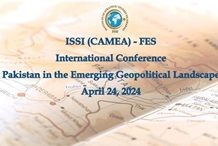The socio-religious dimension
To be fair to history, the entire credit for the initiation of the religious divide in Pakistan cannot be given to Gen Zia-ul-Haq, the then military ruler of the country who had staged a coup to oust and arrest Prime Minister Zulfiqar Ali Bhutto in 1977. The 1973 Constitution of Pakistan not only gave the country the oxymoronic title of ‘Islamic Republic’ but also passed down to parliament the clerical prerogative of deciding matters of an individual’s faith – debatable as even any interference by the church in a human being’s life remains.
The latter had been done through reserving the highest positions of the president and the prime minister for Muslims alone. That, in a nutshell, was the beginning to the process of the state’s politicising religion – thus darkening the vision of the nation’s Founder, Quaid-i-Azam Mohammad Ali Jinnah.
As though that was not enough, the Second Amendment to the Constitution of the Islamic Republic of Pakistan, that came into force on September 17, 1974, declared that all those citizens of the country – or any individual, for that matter – who professes to be an Ahmadi shall be treated by the State as a non-Muslim. A substantial proportion of the nation was relegated the position of second class citizens, along with those already belonging to that category by virtue of professing to belong to the ‘minorities’ of the Christians, the Sikhs, the Hindus, et el.
The sum effect of this constitutional scheme has been the disenfranchisement of large sections of the national population on the one hand, and, on the other, the narrowing down of the political power base first to the Muslims and then those belonging to the majority Sunni sect who too then in this religion-based scramble for legitimised authority were subdivided into any number of sub-sects.
Prime Minister Bhutto followed all that up with a number of legislative measures to further insinuate religious obscurantism in society and state in a vain attempt to placate the right wing that had been bitterly in opposition to the socialistic manifesto of his Pakistan Peoples’ Party ever since its inception in late 1960s.
The army chief, Zia, overthrew his government in July 1977 and set about his mission of ‘Islamizing’ the fabric of the State to acquire a modicum of legitimacy for his 11-year-long dictatorship. The Shiite in Pakistan were in this process victimized through various means.
It was in such a political culture of bigotry and not just religious but also sectarian intolerance in Pakistan that the Shiite of the neighbouring Iran brought about the Islamic Revolution in their homeland. I am a witness to that Revolution. It was by virtue of one’s presence in Tehran during the revolutionary process of 1978-1979 that it was learned how sternly Ayatollah Khomeini had dealt with the first emissaries Zia had sent there to felicitate him and his nation.
Apart from the treatment being meted out to the Shiite in Pakistan at Zia’s hands, there was no love lost between the post-Revolution Iran and the United States of America, with the latter having a history of cyclic ups and downs in its graph of amity with Pakistan almost as old as this country itself is. All that made for anything but the continuity of Pakistan’s close friendly relations with Iran as also of the Persian socio-religious tradition in this country.
Then came the Soviet occupation of Afghanistan. There was a pre-existing basis of alliance between the West and the far-right Sunni factions within the Muslims that had in the first place been patronised by the British during their long colonial rule over most of the Third World lands in which Muslims were in majority.
The British objective here was two-fold. In the first place, it formed part of their dictum of divide and rule. Secondly, they had built their empire on the ruins of three Great Muslim empires through all means fair and foul. Ever so conscious of the nascent movements of Muslim revival, they expended a lot of money and resources to advance, if not actually found, such attempts from within the Muslim communities that were designed to push them back to medieval times.
The axis formed by the United States, some of the Persian Gulf States with Sunni majorities and Pakistan was, therefore, but natural. Even as the Resistance in Afghanistan remained above any sectarian divisions throughout the decade-long Soviet Occupation, Pakistan and Iran both started competing for influence in the immediately neighbouring country after the Soviet defeat and subsequent withdrawal.
That put Pakistan and Iran firmly in two opposing camps. Islamabad had its Taliban in the Pashtun areas of Afghanistan, whereas Tehran had the Northern Alliance comprising the Tajiks, the Uzbeks, the Turkmen, the Hazaras pitted against the Pashtuns. The fratricidal warfare continued till the Americans and their NATO Allies came to occupy Afghanistan in the aftermath of 9/11.
Islamabad still found itself at odds with Tehran, forced as the former was into an alliance with the American war effort in Afghanistan.
Mercifully, all that is behind us. One would therefore consider that the time is opportune for both Pakistan and Iran to waste no time in rekindling the fraternity between them that is rooted in their history, their culture, their literature, their languages – in short, their respective ways of life.
More than ridding the two nations of the misplaced understanding of their shared belief in the moderate, tolerant Islam, the current juncture has also reposed in them the onerous responsibility of showing the right path to the rest of the Muslim community in the world as well.
To conclude, I would cite just one example of how the shared legacy of the two nations can hold each of them in good stead. Revolutionary times need revolutionary zeal. I well remember how the rebellious Persian poetry of Allama Iqbal, or Iqbal-i-Lahori as he is called in Iran, very well served the purpose of instilling that revolutionary spirit as large multitudes marched defiantly on the Tehran streets chanting the verses in unison three decades ago to valiantly topple the tyrannical regime of the Shah. His work became a best seller on the pavements of the city’s downtown alleys.
Iqbal came to have a particular relevance to the Revolution because, as is well known, rich as Persian poetry is in the works of the great classical poets, it does not have much to offer by way of inspiration to revolution, most of it being romantic and mystical in nature.
Views expressed are of the author and do not necessarily reflect the views of ISS or of the Government of Pakistan.












